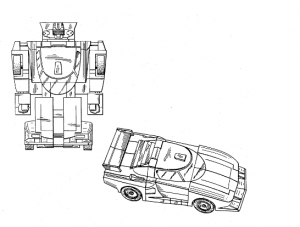Ever since I stowed away Wheeljack in my backpack and took him to summer school, I had been determined to provide him with additional Transformers companions. While he was essentially a plastic toy, there was no doubt in my mind that I wanted to collect more.
Ten years later, I said aloud, “Toy Lawyer.”
I laughed at how ridiculous it sounded.
But then, I googled it to see if this could be a reality.
Spoiler alert, it is a real thing! Though the phrase is probably more of an unofficial moniker that could describe an attorney who works with a toy company. However, the more I investigated, the more I started asking myself why these two words – intellectual property (IP) – repeatedly showed up in podcasts, articles, and just about anything toy-related.
Exploring an Intersection
The answer? Intellectual property rights relate to the development and creation of toys, as well as their commercial successes. From the moment an idea is born and to the day it becomes a product on store shelves, that toy has been through much legal scrutiny.
Some of the most well-known types of intellectual property rights include trademarks, patents, and copyrights. With Transformers, its intersection with and protection by these rights is crucial to its success in pop culture today. To briefly explore this connection, let us delve deeper into how some of these intellectual property terms relate to Wheeljack, both the first Transformers character introduced on the TV show and the first Transformers toy I ever owned.
Diving into the 80s
With the help of the podcast IP Goes Pop! and Google Patents, I managed to first find Wheeljack’s patent PDF that showed the engineering behind the original toy. The patent revealed that on March 8, 1984, the patent application for the design of Wheeljack was filed with the United States Patent Office under the title, “Reconfigurable Toy Vehicle.” More than a year later, on July 30, 1985, the patent was finally granted to its creator Hiroyuki Obara, a Japanese toy inventor.


As I examined the patent, more questions began to arise. What was the connection between Transformers, Obara and Takara? How did this “Reconfigurable Toy Vehicle” come to be known as Wheeljack?
The answer was certainly more than meets the eye. Although The Transformers 1984 animated television series aired in the US, the show’s toy designs actually originated from abroad. In fact, the history of Transformers began with Japanese toy lines. Takara (now Takara Tomy) was a Japanese toy company that first introduced the concept of transforming car-robots in the early 1880s through their Diaclone and Microman toys. Here, Obara was one of the inventors credited for creating these fascinating new playthings.
In fact, Wheeljack was originally released in 1983 with the Diaclone line as Lancia Stratos Turbo, a type of sports car, under a red and green coloring scheme.
Then, in June of 1983, Hasbro, a U.S. toy company, sent a representative to attend the Tokyo Toy Show, who subsequently saw value in the Diaclone and Microman toy lines. This event sparked what would be a long-standing partnership between Takara and Hasbro as Hasbro acquired a license to sell these new toys for American audiences. Thus, the character Wheeljack was officially born, along with other iconic bots, when Marvel Comics’ writers Dennis O’Neil and Bob Budiansky created names and backstories for these novelty toys acquired from Japan.
The “Reconfigurable Toy Vehicle” patent application that Obara filed, along with many others, were character designs that soon became sources of inspiration for Transformers characters like Wheeljack that fans know today. Now, both Takara and Hasbro are copyright holders to the Transformers universe, the characters, and backstories.
The intersection of intellectual property rights with Wheeljack continued as I stumbled across the Gerben Trademark Library, a repository of federally registered trademarks complied by the Gerben Law Firm. Here, I found that Hasbro filed a trademark application for the name Wheeljack on March 28, 2002, which was eventually registered over a year later. Coincidentally, 2002 was also the year that Hasbro and Takara launched Transformers: Armada, where the character Wheeljack resurfaced again after almost 20 years of his on-screen debut.
Since then, Hasbro has consistently integrated Wheeljack into various Transformers media and gave him the screen-time he deserved.
Rolling Out with IP
Though I still collect Transformers figures, I now have a greater appreciation of how they came to be through intellectual property law. Even though we were just briefly looking at Wheeljack, there are thousands of other toys out there, all with stories of their own.
The lawyers in the intellectual property field work alongside countless creative minds to help bring their ideas to life – ideas that could turn into memorable and endearing characters. As I learn more about the world of IP, I feel that working as an attorney for a toy company would perhaps not be too far-fetched of a dream.
At the end of the day, I find the opportunity to bring joy into people’s lives rewarding, whether that be bringing back childhood memories or enriching play experiences for everyone. To be able to hold a toy that came straight from a grid of tiny pixels is truly an incredible experience.
In the meantime, as I wait to join my first IP class next semester, I have attended networking events at school, obtained a mentor, and spoke to attorneys about life in IP. With the assistance and wisdom of wonderful Loyola faculty members and alumni (special thanks to Professor Ho for bringing in opportunities and connections), I am eager to continue exploring my newfound interest.

Ashton Yeh (they/them)
Associate Blogger
Loyola University Chicago School of Law, J.D. 2025
